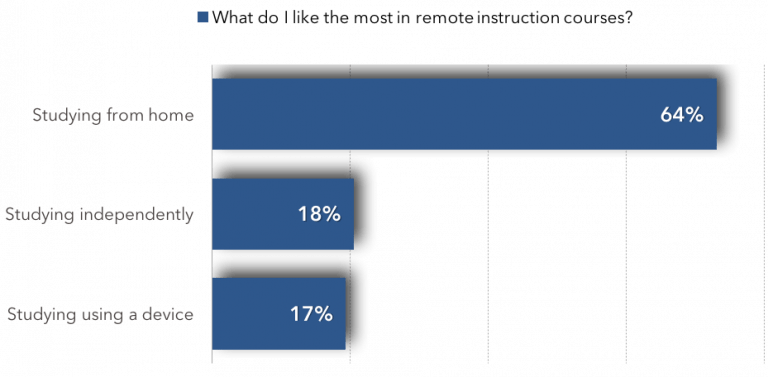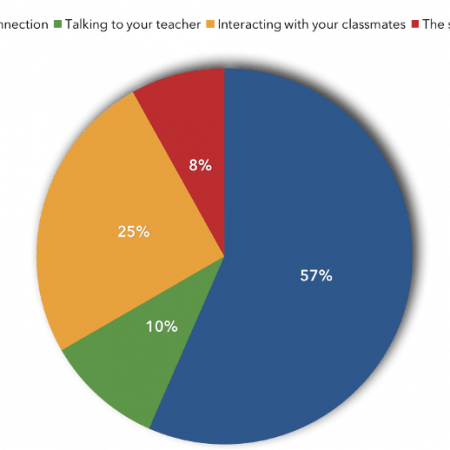Andres PAREDES
Escuela Politécnica Nacional, Ecuador
Andres discusses the findings of a survey on students’ perceptions on the effectiveness of remote instruction for an “English as Foreign Language” (EFL) course in a university in Ecuador.

Most of the world was in quarantine by the end of March, 2020. Entire education systems migrated to remote instruction or some sort of blended education that would allow them to continue class without the face-to-face experience (Castelo, 2020). In Ecuador, schools in the Sierra region wrapped up their second half under remote conditions, and schools in the Coast region prepared to start their 2020-2021 academic calendar without entering the classrooms.
After six months of confinement and social distancing, the experiences that educators, learners and administrators have gained range from anecdotal to relevant pieces of academic information that will become useful for the future of education (Majumdar, 2020).
This paper explores the initial impressions students had about remote instruction. The following results were obtained from “English as Foreign Language” (EFL) students who have been part of a university face-to-face programme and had to switch to remote instruction courses because of the COVID-19 pandemic.
In order to collect data, a digital survey (poll) using Microsoft Forms was administered to 445 EFL students whose proficiency levels varied from A1 to B2 using CEFR guidelines (Cambridge Assessment English, n.d.). The students were part of a continuing education face-to-face programme at one of the state universities in Quito. As the programme switched to remote instruction to ensure continuity, by the time the survey was administered, most students had been studying under the new format for longer than 12 weeks.
Results
The following are the survey results:
- Almost half of the respondents (216 of the 445 surveyed students)felt that they learned the same in remote and face-to-face courses. However, 39% indicated they learned less during remote instruction courses (see Figure 1).

Figure 1. Students’ responses on whether they learnt more, or less, or the same in remote and face-to-face courses - Similarly, 48% felt that the level of difficulty of learning English as a foreign language was the same in both remote and face-to-face courses. For the remaining 52%, the majority felt that remote learning was more difficult than face-to-face courses in terms of the actual learning process, without taking into consideration the technological aspect.

Figure 2. Students’ responses on whether they found remote learning easier or more difficult than face-to-face courses, or the level of difficulty was the same for both kinds of courses - Close to two-thirds of the respondents selected the possibility to study directly from home as the feature they liked the most about remote instruction. Opinions were divided among the other two options, which included studying independently and studying using a digital device (see Figure 3).

- In contrast, when asked to state what they missed the most about face-to-face courses, 60% indicated that they longed to have direct, personal contact with their teachers. 22% answered that they missed being with their classmates, and 17% missed being in the classroom (see Figure 4).

- Only 5% of respondents answered that they learn English (EFL) better in remote instruction courses. The majority (57%) stated that they learned better via face-to-face courses (see Figure 5).

- Switching to remote instruction courses came rapidly and in some cases, abruptly. Students were asked what the biggest obstacle in remote instruction was, and most (57%) indicated that Internet connectivity represented the biggest obstacle (see Figure 6), followed by peer interaction (25%).

- More than three-quarters of the respondents stated that they would return to the face-to-face classroom once the pandemic is over (see Figure 7). 12% said they will not return to an onsite course.
-

Figure 7. Students’ responses to the survey question “Would you return to the face-to-face classroom once the emergency is over?”
In summary, the survey findings indicate that respondents were uncertain about the real potential of remote instruction because most perceived this format as a temporary solution linked to preventing the spread of COVID-19 and offering the convenience of studying from home (Brzoska, 2020). There is much more to explore in terms of the effectiveness of remote courses in language learning and the acceptance rate of these kinds of courses once the emergency is over (Miller & Paredes, 2017). However, one conclusion that could be made from the survey findings is that classroom interaction with the teacher is still viewed as a crucial source of support in the learning process. Educators and administrators need to be aware of this factor as they strive to move forward towards new teaching practices.
 |
Mr. Andres PAREDES has worked in the education field both as an instructor and administrator since 1994. He is the co-author of the National EFL curriculum implemented by the Ecuadorian Ministry of Education since 2016. He has written and reviewed several EFL textbooks. His seminars and research projects have been presented around the world including at TESOL Conventions. Andres can be reached at andresee@hotmail.com. |
References
Brzoska, K. (2020). Learning in the time of COVID-19, what do learners find challenging? Cambridge University Press. https://www.cambridge.org/elt/blog/2020/08/28/learning-time-covid-19/
Cambridge Assessment English (n.d.). International Language Standards. Cambridge Assessment. https://www.cambridgeenglish.org/exams-and-tests/cefr/
Castelo, M. (2020). How to set a virtual classroom. Ed Tech Magazine. https://edtechmagazine.com/k12/article/2020/08/how-set-virtual-classroom
Majumdar, B. (2020). How does remote learning affect student achievement? MultiBriefs. https://exclusive.multibriefs.com/content/how-does-remote-learning-affect-student-achievement/education
Miller, K., & Paredes, A. (2017). Can I really learn english online? What students believe. TESOL Video News. http://newsmanager.commpartners.com/tesolvdmis/issues/2017-02-15/2.html

